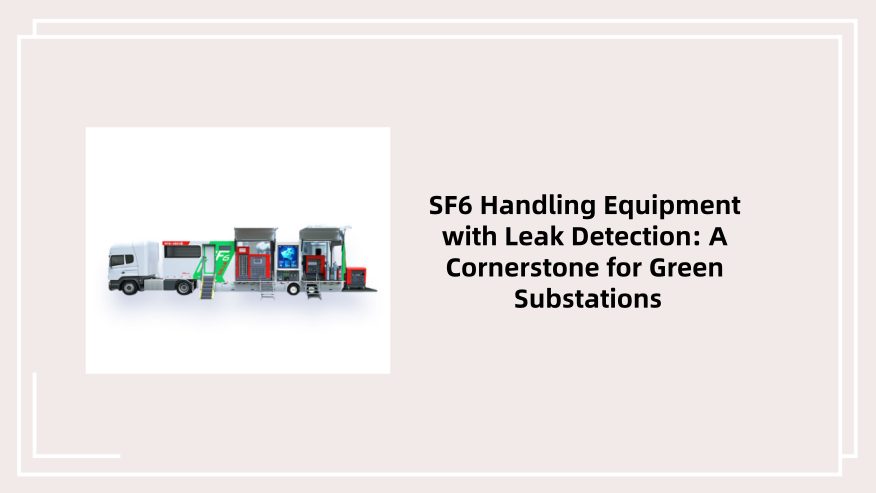
- SF6 Relations
- 2025-10-15
As the global energy sector shifts toward carbon neutrality, green substations—critical hubs for transmitting renewable power—are no longer just a trend but a necessity. However, one persistent challenge threatens their sustainability goals: sulfur hexafluoride (SF6). A potent greenhouse gas with a global warming potential (GWP) 23,500 times that of CO₂ over 100 years, SF6 is widely used in substations for its exceptional insulation and arc-quenching properties. The solution? SF6 handling equipment with leak detection function—an innovation that balances operational efficiency with environmental responsibility.
Why SF6 Leaks Undermine Green Substation Goals
SF6’s stability makes it ideal for high-voltage equipment, but it also means leaked gas lingers in the atmosphere for centuries. Even small leaks (as little as 1% of a substation’s SF6 inventory annually) can negate the carbon savings from renewable energy integration. Traditional SF6 handling processes—such as manual recovery or unmonitored refilling—often miss these leaks, leading to regulatory non-compliance (e.g., the EU’s F-Gas Regulation) and reputational damage for utilities. For green substations, which prioritize low emissions and circularity, uncontrolled SF6 leaks are a critical barrier to meeting sustainability targets.
Key Features of SF6 Handling Equipment with Leak Detection
Modern SF6 handling equipment with leak detection is designed to address these gaps through three core capabilities:
Real-Time Leak Monitoring: Integrated sensors (e.g., infrared or acoustic detectors) continuously scan for SF6 concentrations, triggering alerts at leak rates as low as 0.1 kg/year—far below industry averages. This eliminates the need for periodic manual inspections, which are time-consuming and prone to human error.
Closed-Loop Handling: Unlike conventional equipment that vents excess SF6, these systems recover, purify, and reuse the gas. The leak detection function ensures no gas escapes during recovery, refilling, or maintenance, creating a circular lifecycle for SF6 and reducing reliance on new gas purchases.
Data-Driven Insights: Many models sync with substation management software, logging leak locations, frequency, and volume. This data helps utilities identify aging equipment (a common leak source) and optimize maintenance schedules—boosting both sustainability and operational reliability.
Benefits for Green Substations: Environmental, Economic, and Regulatory
The impact of this equipment extends beyond emissions reduction:
Environmental: By minimizing leaks, utilities can cut their SF6-related carbon footprint by up to 90%, aligning green substations with global climate goals (e.g., the Paris Agreement). For example, a 500 kV green substation using leak-detection-enabled SF6 equipment can avoid releasing 50+ tons of CO₂-equivalent annually.
Economic: Recovering and reusing SF6 reduces procurement costs by 30–40%, while early leak detection prevents expensive equipment failures (e.g., arc flash incidents caused by low SF6 levels). Additionally, compliance with F-Gas and similar regulations avoids fines that can exceed $10,000 per violation.
Regulatory Alignment: As governments tighten SF6 emissions rules (e.g., the U.S. EPA’s proposed SF6 phase-down), this equipment ensures green substations meet mandatory leak rate limits (often ≤0.5% annually) and reporting requirements.
Choosing the Right Equipment for Your Green Substation
When selecting SF6 handling equipment with leak detection, prioritize:
Accuracy: Look for detectors certified to IEC 61779 (the global standard for SF6 leak measurement).
Compatibility: Ensure the system works with your substation’s equipment (e.g., GIS, circuit breakers) and integrates with existing sustainability management tools.
Portability: Mobile units are ideal for field maintenance, while fixed systems suit permanent substation setups.
Green substations are pivotal to a renewable energy future, but their success depends on addressing SF6’s environmental impact. SF6 handling equipment with leak detection function is not just a tool—it’s a strategic investment that safeguards sustainability, cuts costs, and ensures regulatory compliance. As utilities accelerate their green transition, adopting this technology will become less of an option and more of a requirement to build truly low-carbon power grids. For any organization committed to green substations, the message is clear: prioritize SF6 leak detection, and prioritize long-term environmental leadership.
Leave a Reply